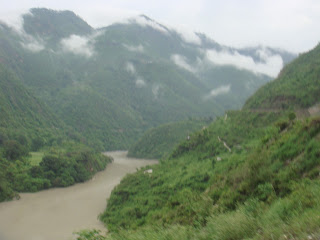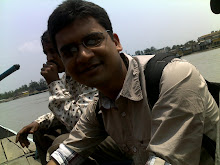Continued From:
Day 3:
Date: 20th June
Time: About 5 a.m. in the morning
Location: A hotel in Govindghat.
For the second consecutive day, we started our journey early in the morning. This day was special to us in many aspects. From now onward we were on foot. This day also marked the start of mountain trekking, the flagship feature of our trip. We were to spend next few days on mountains without any connection with the outer world.
Day 3:
Date: 20th June
Time: About 5 a.m. in the morning
Location: A hotel in Govindghat.
For the second consecutive day, we started our journey early in the morning. This day was special to us in many aspects. From now onward we were on foot. This day also marked the start of mountain trekking, the flagship feature of our trip. We were to spend next few days on mountains without any connection with the outer world.
 |
| At the bridge |
The route to Ghanghariya starts after crossing the bridge over Alaknanda. Early in the morning, the view near the bridge was amazing. Hundreds of people were standing near the Gurudwara to cross the bridge notwithstanding the rain which was drizzling from the sky. It was still dark but the vibrant atmosphere at the bridge was defying all the odds. We planned to start early but right from the beginning all our plans fall apart. Before commencing our trekking we needed three essential things- Raincoats, Sticks and Mule to carry our luggage. Unfortunately we were unable to arrange for any of them.
More than an hour passed and we didn’t make any progress. We managed to arrange for sticks but the raincoats and Mule was still out of reach. After some time “Tourist Help Center” opened and we took the raincoats on rent. The quality of the raincoats was far better than the ones which were available in the market. Mule to carry our luggage to the destination was still elusive. Finally we decided to go across the bridge to look for Mule carriers. We managed to talk to a couple of Carriers but all of them had one condition-One person among us should accompany them to Ghanghariya, to this none of us agreed. Finally one Mule Carrier agreed to take our luggage on the condition that he will take his own route and will reach Ghanghariya at his own time. Seeing no other option we agreed to him, knowing little that this will lead to some other crazy incident in the evening.
Finally our trekking started and we marched toward Ghanghariya. Soon our group split into two subgroups. I, Parag, Arjun and Arpit were walking at our pace while Abhinav, Dixit and Pelu were coming behind us. Rain stopped, Sunlight appeared, weather improved and we continued our journey.
 |
| Our fellow traveler |
For the first time in our trip we witnessed mountains from such a close distance. A big wall of stone on one side and a thousand feet deep valley on the other was enough to prod us for the journey. Early in the morning we even witnessed the trace of the clouds from close vicinity. The road to Ghanghariya was busy with fellow travelers. Incidentally we were the only group on the path without any Sikh member. The road was populated not only by humans but also by horses which were crossing us at regular intervals. Soon we found a beautiful water-fall along the side of the road. Here we relaxed and clicked some photos. The journey continued with breaks at regular intervals. The whole path was crowded by dhabas which were selling food items at a premium. As the altitude increased, the prices of the food stuff also increased. By the end of the journey our fatigue and tiredness was at its optimal level. Normal food stuff was not helping any more. To our comfort we found a langar being managed by the volunteers, which was distributing dry fruits and drinks.
 |
| Legendary pic |
When we were close to our destination we asked a person to take a group photo of us. While taking the snap he walked few steps back to accommodate all of us and the beautiful scenery behind us in the photo. Suddenly he lost the control and fall on the other side of the road. The scene was funny. He was lying among the plants with his pant torn in a 3 to 4 feet deep pit. We were laughing at the scene and he also joined us in the laugh. He got up, brushed himself and took our snap.
Our 13 k.m. long trekking ended at a Police Chowky which is a sort of landmark in that area. We found our luggage lying there in a dumped state. All of us checked our luggage and I found that my bag has been exchanged with some other bag. Its implications were that all my clothes, blankets and most importantly money has also gone with that bag. The situation was serious not only for me but also for the whole group because it was now my turn to pay the money for our expenses. Hundreds of travellers have crossed that path every hour since morning. Searching for a bag in the thousands of tourists over there was like looking for a needle in a haystack. To make the situation worse the mule owner who brought the luggage here was also missing. I went to Gurudwara and asked the Granthi to make an announcement about a blue bag being exchanged. He asked me to deposit the bag I have at Gurudwara. While at Gurudwara I looked for the bag among hundreds of pilgrims who were staying over there but the chances of locating a small bag among hundreds similar were very remote.
While I was coming back to our base from the Gurudwara, I was looking at the restaurants and dhabas with the hope of finding a clue about my bag and BINGO!!! There was it, lying near a chair, in a dhaba, with a lady. I went to her and said in a polite tone, “Mata Ji, Ye Bag…” and she started in a full Punjabi tone, “Oye Badal Gaya, Oye Badal Gaya”. And here it was, my bag, my and ours group Lifeline for the rest of the tour.
 |
| View from the room |
We went ahead, looked for the rooms in the hotel, even contemplated about staying in the Gurudwara and finally booked the room at a whopping Rs.4000 for a day. I don’t think any other place in India commands such a high premium. Even a STD call was charged at Rs.20 per minute.
The room was damp, dark and dingy. The only savior was the view that the room provided-beautiful, sky kissing mountains. That was all for the day. Next day we had to visit, “VALLEY OF FLOWERS”. |
| Our Route (From A to B) |
To be continued:





















